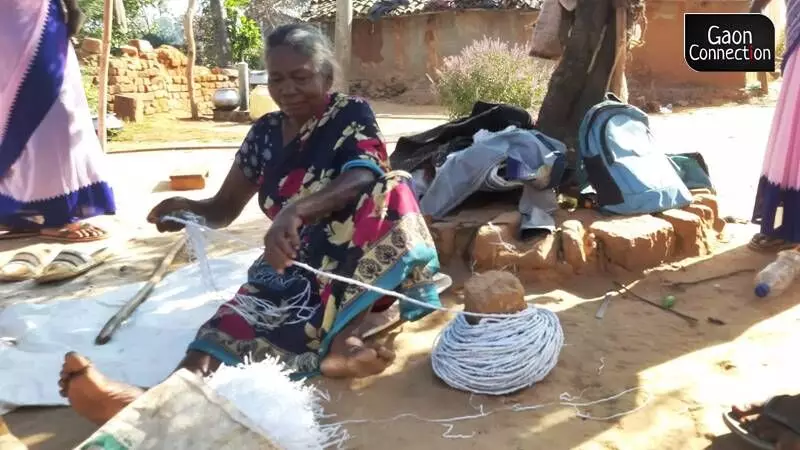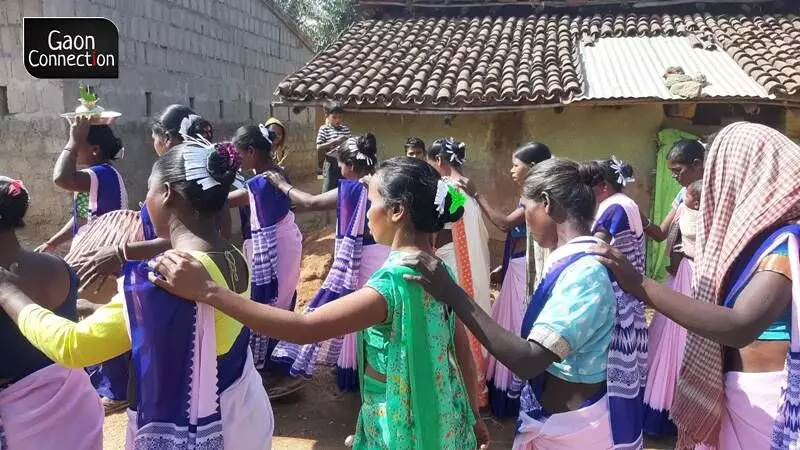Jehen Gutwa (Gumla), Jharkhand
Jharkhand is a land of 32 listed tribes, out of which eight tribes have been categorised as particularly vulnerable tribal groups (PVTGs). Birhor tribe is one of the PVTGs in the state with about 10,000 of its community members spread across the landscape. PVTGs are more vulnerable than other tribal communities in the country.
The word Birhor signifies ‘dweller of the jungle.’ The name of this tribal group is a combination of two words namely ‘bir‘ which means jungle, and also ‘hor‘, which means man. It is believed that Birhors were the first to inhabit the forest of India, and were a nomadic tribe that moved from place to place in forests.
Today, the Birhors are an extremely marginalised community trapped in poverty and social exclusion. Jehen Gutwa village in Gumla district of Jharkhand is a predominantly Birhor village with 35 PVTG families residing in its Birhor Colony.
Shilo Birhor, an inhabitant of this village located about 95 kilometres from the state capital Ranchi, had lived in abject poverty for most of her 50 odd years of life. Her primary means of earning was rope making, while her husband and other male members of the family migrated, mostly to Tripura in the northeast, in search of work.

Birhor tribe is one of the PVTGs in the state with about 10,000 of its community members spread across the landscape.
But now, Shilo not only grows vegetables for her family’s consumption and sale in the local market, but is also engaged in pig farming.
Like Shilo, other Birhor women in the village, who until two years ago practised rope-making are now cultivating land, growing food, and leading a healthier life.
Also Read: Once migrant labourers at brick kilns, women in Lohardaga now farm their land and rear pigs
The winds of change started to sweep in Jehen Gutwa in November 2020, when 18 Birhor women from the village were chosen to receive a grant of up to Rs 22,000 each from The/Nudge Institute, a Bengaluru-based non profit, as part of its initiative called End Ultra Poverty (EUP) programme. The programme has been supported by the Deendayal Upadhyay-National Rural Livelihood Mission of the Ministry of Rural Development, and the Jharkhand State Livelihood Promotion Society (JSLPS).
“We taught the Birhor women about soil quality, its productivity for a particular crop, how to prepare the land for best cultivation, and about the correct use of fertilisers and pesticides, so that they could practise cultivation,” Kailash Mahto, team leader of The/Nudge Institute in Gumla, told Gaon Connection.
The EUP programme has not just provided the tribal women the grant, but conducted training capsules for cultivation and animal husbandry that are helping them augment their income. Two training sessions are conducted for the Birhor women every month.
Women like Shilo are now trained in agricultural practices as well as animal husbandry as they have been taught how to make cattle sheds, what to feed the livestock, and how to keep them vaccinated, Mahto added.

Today, the Birhors are an extremely marginalised community trapped in poverty and social exclusion.
A struggle for survival for the rope-making PVTG
“Most of the women here have been making ropes for generations. We make ropes and sell them at the weekly market, along with some timber. It is the primary source of income for us,” Shilo told Gaon Connection.
Rope making is hard work and the returns are pitiful, the Birhor women complained. “We purchase plastic bags at four rupees each from the local market. We then open them into stripes manually and knit the strips together to make ropes. One big plastic bag makes about two metres of rope and it takes a day to make that length,” Saraswati Birhor who also lives in Jehen Gutwa village, told Gaon Connection.
“We sell the two-metre ropes at Rs 40 each. We make up to Rs 800 a week when we sell them at the weekly market in Bishnupur,” Saraswati added.
It is only the women of the Birhor community who make ropes. Originally they made ropes with what they found in the forests, but moved to plastic, when that became available to them. The men, most of them, migrate from the villages, usually towards Tripura in the north east, looking for jobs.

It is believed that Birhors were the first to inhabit the forest of India, and were a nomadic tribe that moved from place to place in forests.
According to Shilo, the men would be out for nearly six months in a year and return home with no more than Rs 10, 000 in hand. “We managed to feed our families with the money we made with our ropes,” Shilo said. “We have seen only poverty for generations and our children have been deprived of any kind of education,” she added.
Also Read: Lohe ki kadhai and tricolour thaali show the way to a nutritious life in Jharkhand
Vegetable cultivation and better nutrition
“Easily available saag (greens) and mar-bhat (rice with starch) with salt was our diet. But now, after our training we have started growing our own vegetables, pulses, rice,” Shanti Birhor who has started growing spinach, coriander and other vegetables in a tiny space outside her house, told Gaon Connection.
Many of the families that had tiny plots of barren land of not more than five to 10 dismil (100 dismil = 1 acre), have managed to prepare those plots and are cultivating vegetables on them.
After Chando Birhor received the grant of Rs 22, 000 and underwent training in agriculture and animal husbandry, she has begun to grow tomatoes and ladyfingers.
“I also purchased a pig and it will be sold when the prices go up in the wedding season,” Chando told Gaon Connection. “Previously, my husband would migrate to find a job elsewhere, but now, he tends to the vegetables we grow and is home with me,” she added smilingly.
Also Read: Jharkhand Women Become Pashu Sakhis, Treat Goats
Asrita Birhor who invested Rs 3,000 from her grant money on seeds, pesticides, and medicine for her animals said she made profits. “Last year, I grew ladies finger and bitter gourd, and made a profit of Rs 5,000 from just one harvest,” she told Gaon Connection.
“This year, I grew chilli and tomato and earned Rs 8,470 from it,” she said. The area is dependent on the monsoon for irrigation and because of other irrigation facilities, they are unable to grow onion and potato, as they would like to, Asrita added.
According to Chando, the training provided by The/Nudge Institute has gone a long way in improving their lives. “Women now take better care of the livestock and protect them from disease. And the grant has helped us construct shelters for the animals, and the training programmes have informed us about their upkeep and diet. This ensures better health and longevity of the animals,” she said.
The village SHG comes to life
While there has been a Self Help Group (SHG) in the Jehen Gutwa village called Jeevan Ajivika Swayam Sahayata Samooh since 2015, it was not very active. The village women did not contribute anything to it as they were always strapped for money.
However, now that the women have begun to earn better, the SHG has seen a revival. They now contribute a weekly amount of Rs 10 to Rs 20. One lakh rupees is currently deposited with the SHG which then gives them the benefit of taking a loan at a very low annual interest rate of two per cent.
This has yielded unexpected results. Saraswati Birhor who took a loan of Rs 3,000 to start an egg selling business earned a profit of Rs 8,000. The offshoot of this business was that the village children now have eggs to eat with their regular diet, she said.
Earlier, Birhor families spent around Rs 350 every week to buy food stuff. Now that they are getting vegetables from their own kitchen gardens, they are saving that money.
Also Read: Four-legged ATM cards empowering Jharkhand women
Mina Birhor had bought four pigs and now has seven more piglets. She said she sold one pig for Rs 4,000 and is waiting for the marriage season that will fetch her a better price for her animals.
“We now help our husbands financially. Our children go to schools and finally our voices are being heard,” Mina smiled. She said that many of the women were now training their husbands in cultivation work.
“Now our animals reside in the kuchha homes where we once lived. Many of us have constructed cemented homes. A couple of villagers have purchased irrigation machine pumps. They have also bought pesticide sprayer machines,” Chando said.
Three of her own children, for whom education was a dream, are now enjoying quality education at a local middle school, Chando, who has herself studied till class 10, informed Gaon Connection, happily.




















